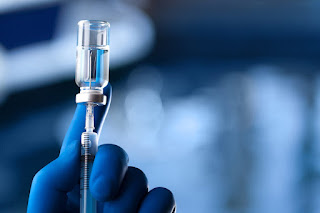
A vaccine is a biological preparation that provides active acquired immunity to a specific infectious disease. A vaccine generally contains an active ingredient that resembles a pathogenic microorganism and is often made from weakened or killed forms of the microbe, its toxins, or one of its surface proteins. Vaccines can be administered as an oral vaccine, or injected by a needle. Vaccines have helped to fight and even eradicate many diseases that had fatal outcomes for many people in the past.
Vaccines prevent more than 2.5 million deaths each year.
In the 10th century in China there were attempts to inoculate for smallpox. This form of inoculation involved inhaling smallpox scabs into the nostrils.
In the past 60 years, vaccines helped eradicate one disease (smallpox) and are close to eradicating another (polio).
In the 1700s Edward Jenner discovered that cowpox could be administered to humans to create immunity against smallpox. This practice continued until 1840.
Scientific studies and reviews continue to show no relationship between vaccines and autism.
In the 1880s Louis Pasteur created vaccines for anthrax and chicken cholera. He was also responsible for discovering pasteurization.
Vaccines helped reduce measles deaths globally by 78% between 2000 and 2008.
Vaccines have been created to prevent a variety of diseases including diphtheria, mumps, measles, rubella, smallpox, polio, whooping cough, chicken pox, shingles, hepatitis A, hepatitis B, pneumonia, meningococcal disease, tetanus, human papillomavirus, and influenza.
There are existing vaccines that could stop rotavirus and pneumonia — two conditions that kill nearly 3 million children under the age of five every year.
When the majority of people in a community are vaccinated, this provides what is referred to as ‘herd immunity’ for those in the community not vaccinated. This means that they are less likely to get sick from the disease because the potential for the disease to exist and spread is lower.
The CDC has reported a 99% reduction in the incidence of bacterial meningitis caused by Haemophilus influenzae since the introduction of the vaccination against the disease in 1988.
Thanks to the polio vaccine the disease no longer occurs in the United States, but polio is very contagious and if it were brought to the United States by an infected person it could spread rapidly.
Researchers estimate that a viable malaria vaccine could be ready for children in the developing world as early as 2015.
Pakistan, Nigeria, and Afghanistan still have cases of polio, but elsewhere is has been eradicated because of vaccines.
Most diseases prevented by vaccines are no longer common in the United States. If vaccines weren’t used, just a few cases could quickly turn into tens or hundreds of thousands.
There are still a million young children dying each year from rotavirus and pneumococcal disease, which are preventable with vaccines.
Babies get their first vaccinations when they are 8 weeks old. These vaccinations will protect against measles, rubella, tetanus and meningitis.
There are several different types of vaccines including inactivated, attenuated, toxoid, subunit, conjugate, valence, heterotypic, and experimental.
Since 2000, the measles vaccine has saved more than 21 million lives around the world.
Vaccines are used to help prevent disease among animals too. The rabies vaccine can help stop the spread of this deadly disease. Both people and animals can be vaccinated against rabies, which can spread from animal to human when a human is bitten by a sick animal. It is estimated that the rabies vaccine saves approximately 250,000 lives a year around the world.
Every $1 invested in immunizations yields $44 in economic and social benefits, according to UNICEF.
Some vaccines must be given in repeated doses to help build immunity.
The United States is a leading supporter of global immunization programs, which account for less than 1% of the U.S. federal budget.
Some people believe that vaccinations can cause other illnesses such as autism, but it has not been proven yet.
More than 90 countries have introduced rotavirus vaccines as part of their national immunization programs.
Vaccines do not always work. Some people can be vaccinated for a disease and still get the disease, but they do work in most cases.








